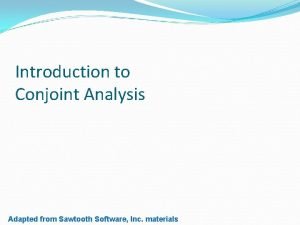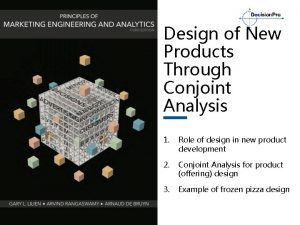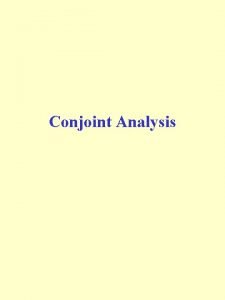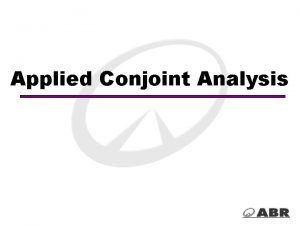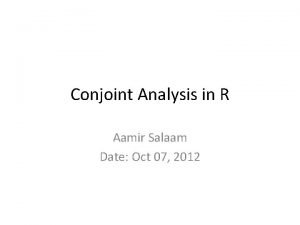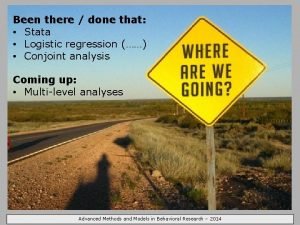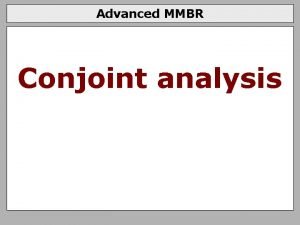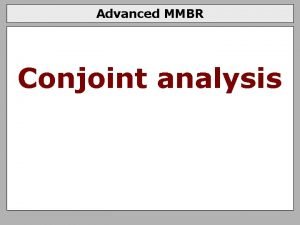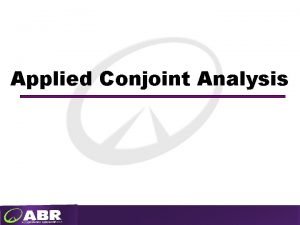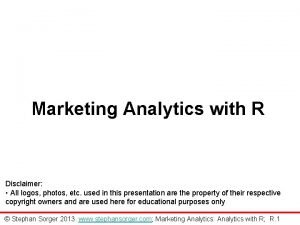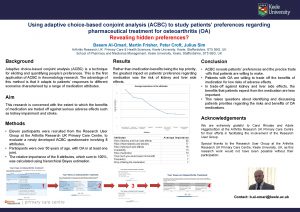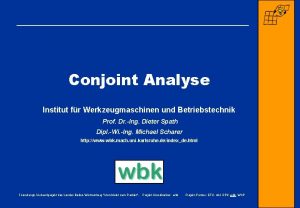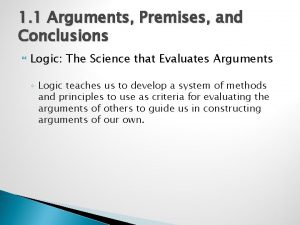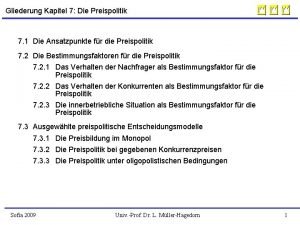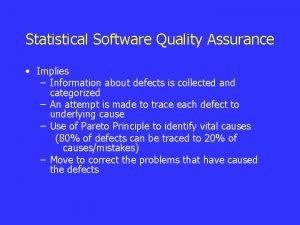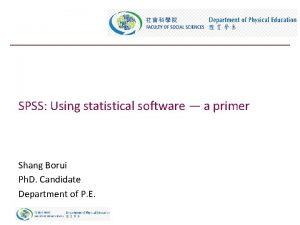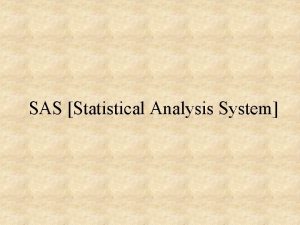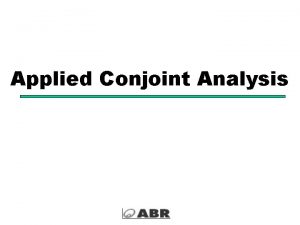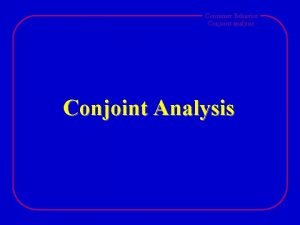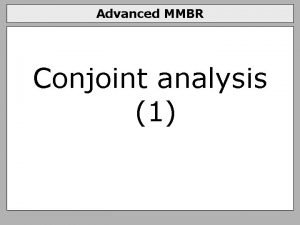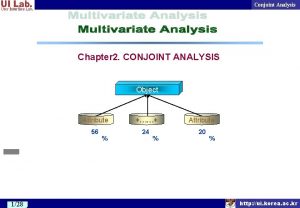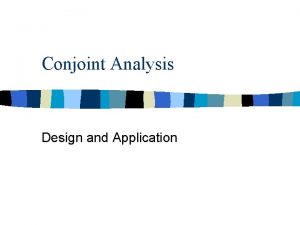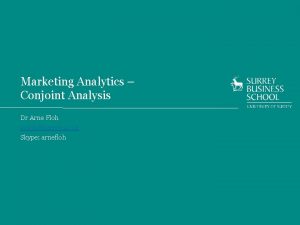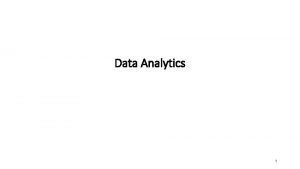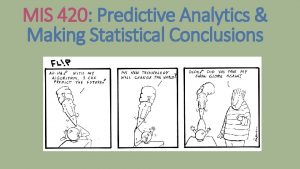Marketing Analytics Technology Statistical Analysis Software R Conjoint


































- Slides: 34

Marketing Analytics Technology: Statistical Analysis Software & R Conjoint Analysis Using R PREREQUISITE: R BASICS Stephan Sorger www. stephansorger. com Disclaimer: • All images such as logos, photos, etc. used in this presentation are the property of their respective copyright owners and are used here for educational purposes only • Some material adapted from: Sorger, “Marketing Analytics: Strategic Models and Metrics” © Stephan Sorger 2015: www. stephansorger. com; Marketing Analytics; Tech: R Conjoint: 1

Outline: 10 Steps to Conjoint Analysis Topic Discussion 1. Attribute Selection 2. Attribute Level Selection 3. Product Bundle Formation 4. Data Collection Method Selection 5. Data Collection 6. Data Preparation 7. Importance Weights Calculation 8. Part-Worth Calculation 9. Market Share Estimation 10. Data Interpretation Select relevant product characteristics Identify levels of characteristics Create sample products by bundling Decide how to collect data Ask responders to rate products Get data ready for conjoint Assess importance of each attribute Assess importance of each level Predict preferences of products Compare against industry averages © Stephan Sorger 2015: www. stephansorger. com; Marketing Analytics; Tech: R Conjoint: 2

Conjoint Analysis Example Topic Discussion Acme Espresso You are the marketing manager for Acme Espresso Machine Small manufacturer of premium coffee makers Competitors: Breville, De. Longhi, Gaggia, Rancilio © Stephan Sorger 2015: www. stephansorger. com; Marketing Analytics; Tech: R Conjoint: 3

Conjoint Analysis Example Topic Discussion Objectives Understand how consumers assess different products Identify specific features desired by consumers Predict market share for different product variants Conjoint Conduct conjoint analysis to address objectives Use 10 -step process Steps 1 - 5 Review Steps 6 - 10 Execute using R © Stephan Sorger 2015: www. stephansorger. com; Marketing Analytics; Tech: R Conjoint: 4

Step 1: Attribute Selection Topic Discussion Attributes Characteristics that consumers find relevant when evaluating Research Secondary: Product reviews, etc. Primary: Customer surveys Speed Brewing time, in minutes Capacity Number of cups machine can brew Price Retail price of espresso machine © Stephan Sorger 2015: www. stephansorger. com; Marketing Analytics; Tech: R Conjoint: 5

Step 2: Attribute Level Selection Topic Discussion Levels Identify levels of attributes where consumers see differences Two Levels In this exercise, we will identify two levels for each attributes Speed S 1: “Fast”: Under 1 minute S 2: “Slow”: 1 minute of more Capacity C 1: “Single-Cup”: 1 cup at a time C 2: “Multi-Cup”: Multiple cups at a time Price P 1: “Budget”: Price under $300 P 2: “Premium”: $300 or more © Stephan Sorger 2015: www. stephansorger. com; Marketing Analytics; Tech: R Conjoint: 6

Step 3: Product Bundle Formation Topic Discussion Bundles Create candidate products by bundling together attributes Vary the levels of the attributes Bundles often called cards (Levels) ^ (Attributes); 2^3 = 8 Quantity Card/Bundle 1 2 3 4 5 6 7 8 Speed (S) 1 1 2 2 Capacity (C) 1 1 2 2 Price (P) 1 2 1 2 © Stephan Sorger 2015: www. stephansorger. com; Marketing Analytics; Tech: R Conjoint: 7

Step 4: Data Collection Method Selection Topic Discussion Pairwise Comparison Respondents compare pairs of options Rank Ordering Respondents place options in rank order: 1 – 100 Rating Scale* Respondents rate each option independently Data Collection Techniques Pairwise Comparison Rank Ordering Rating Scale © Stephan Sorger 2015: www. stephansorger. com; Marketing Analytics; Tech: R Conjoint: 8

Step 5: Data Collection Topic Discussion Rating Scale Ask respondents to rate each card on a scale from 1 to 5 1 = poor; 5 = outstanding Card/Bundle 1 2 3 4 5 6 7 8 Speed (S) 1 1 2 2 Capacity (C) 1 1 2 2 Price (P) 1 2 1 2 Preference 4 3 5 4 3 1 3 2 © Stephan Sorger 2015: www. stephansorger. com; Marketing Analytics; Tech: R Conjoint: 9

Step 6: Data Preparation Topic Discussion Data Prepare the data for use with R Same data we used for Microsoft Excel approach Step A B C D E F Data Preparation Download R Launch R Install the R conjoint package Load the conjoint library Convert data set from Excel-friendly format to R-friendly format Load the data into R © Stephan Sorger 2015: www. stephansorger. com; Marketing Analytics; Tech: R Conjoint: 10

Step 6: Data Preparation; A: Download R Platform Link Windows http: //cran. r-project. org/bin/windows/base/ Mac http: //cran. r-project. org/bin/macosx/ © Stephan Sorger 2015: www. stephansorger. com; Marketing Analytics; Tech: R Conjoint: 11

Step 6: Data Preparation; B: Launch R Topic Discussion Prompt You will see a “>” prompt in the “R Console” You will be typing commands at the prompt: “ > “ © Stephan Sorger 2015: www. stephansorger. com; Marketing Analytics; Tech: R Conjoint: 12

Step 6: Data Preparation; C: Install R Conjoint Package Topic Discussion Packages Need special functionality to execute our conjoint analysis R extends it functionality through functions called packages (1) Conjoint Package called “conjoint” for conjoint analysis (2) Syntax: install. packages(“packagename”) Our case: install. packages(“conjoint”) (See next few slides for screenshots) (1) R Documentation, “Install Packages from Repositories http: //stat. ethz. ch/R-manual/R-devel/library/utils/html/install. packages. html (2) R Documentation, Package “Conjoint”. August 29, 2013. Bak, Andrej and Bartlomowicz http: //cran. r-project. org/web/packages/conjoint. pdf © Stephan Sorger 2015: www. stephansorger. com; Marketing Analytics; Tech: R Conjoint: 13

Step 6: Data Preparation; C: Install R Conjoint Package Topic Discussion Screenshot install. packages(“conjoint”) © Stephan Sorger 2015: www. stephansorger. com; Marketing Analytics; Tech: R Conjoint: 14

Step 6: Data Preparation; C: Install R Conjoint Package Topic Discussion Screenshot Downloading multiple files in package © Stephan Sorger 2015: www. stephansorger. com; Marketing Analytics; Tech: R Conjoint: 15

Step 6: Data Preparation; C: Install R Conjoint Package Topic Discussion Screenshot Package elements unpacked successfully © Stephan Sorger 2015: www. stephansorger. com; Marketing Analytics; Tech: R Conjoint: 16

Step 6: Data Preparation; D: Load Conjoint Library Topic Discussion Load files library(conjoint) © Stephan Sorger 2015: www. stephansorger. com; Marketing Analytics; Tech: R Conjoint: 17

Step 6: Data Preparation; E: Convert Data Set to R Format Topic Discussion Preferences Matrix dedicated to preferences stated by respondents Card/Bundle 1 2 3 4 5 6 7 8 Speed (S) 1 1 2 2 Capacity (C) 1 1 2 2 Price (P) 1 2 1 2 Preference 4 3 5 4 3 1 3 2 © Stephan Sorger 2015: www. stephansorger. com; Marketing Analytics; Tech: R Conjoint: 18

Step 6: Data Preparation; E: Convert Data Set to R Format Topic Discussion Profiles Matrix dedicated to description of data structure Card/Bundle 1 2 3 4 5 6 7 8 Speed (S) 1 1 2 2 Capacity (C) 1 1 2 2 Price (P) 1 2 1 2 © Stephan Sorger 2015: www. stephansorger. com; Marketing Analytics; Tech: R Conjoint: 19

Step 6: Data Preparation; E: Convert Data Set to R Format Topic Discussion Profiles Matrix dedicated to description of data structure © Stephan Sorger 2015: www. stephansorger. com; Marketing Analytics; Tech: R Conjoint: 20

Step 6: Data Preparation; E: Convert Data Set to R Format Topic Discussion Profiles Save As CSV © Stephan Sorger 2015: www. stephansorger. com; Marketing Analytics; Tech: R Conjoint: 21

Step 6: Data Preparation; F: Load Datasets Into R Topic Discussion Preferences Profiles preferences<-read. csv(“C: \Users\user\Desktop\preferences. csv”, header=T) profiles<-read. csv(“C: \Users\user\Desktop\profiles. csv”, header=T) © Stephan Sorger 2015: www. stephansorger. com; Marketing Analytics; Tech: R Conjoint: 22

Step 7: Importance Weights Calculation Topic Discussion Importance Calculate importance weights in conjoint Refers to importance of each attribute, such as speed ca. Importance R command built into the conjoint analysis (ca) package Syntax ca. Importance(preferences, profiles) ca. Importance = conjoint analysis function for importance preferences = matrix with preferences for each card profiles = matrix describing each profile or card Command importance <- ca. Importance (preferences, profiles) © Stephan Sorger 2015: www. stephansorger. com; Marketing Analytics; Tech: R Conjoint: 23

Step 7: Importance Weights Calculation © Stephan Sorger 2015: www. stephansorger. com; Marketing Analytics; Tech: R Conjoint: 24

Step 7: Importance Weights Calculation Topic Discussion Comparison We compare the Excel results with the R results Variable Speed Capacity Price Total Excel Coefficient % of Total 1. 75/3. 75=46. 67% 0. 75: absolute value 0. 75/3. 75=20. 00% 1. 25/3. 75=33. 33% 3. 75/3. 75=100% R Results 46. 67% 20. 00% 33. 33% 100% © Stephan Sorger 2015: www. stephansorger. com; Marketing Analytics; Tech: R Conjoint: 25

Step 8: Part-Worth Calculation: Levelnames Matrix Topic Discussion Levelnames Matrix to capture names of levels for each attribute Speed: fast, slow Capacity: onecup, twocups Price: cheap, expensive © Stephan Sorger 2015: www. stephansorger. com; Marketing Analytics; Tech: R Conjoint: 26

Step 8: Part-Worth Calculation: Calculate Part Worths Topic Discussion Read data Command levelnames<-read. csv(“C: \Users\user\Desktop\levelnames. csv”, header=T) partutil <- ca. Part. Utilities (preferences, profiles, levelnames) © Stephan Sorger 2015: www. stephansorger. com; Marketing Analytics; Tech: R Conjoint: 27

Step 8: Part-Worth Calculation: Examine Part Worths Topic Discussion Part Worths intercept fast 3. 125 0. 875 slow -0. 875 onecup -0. 375 twocups cheap 0. 375 0. 625 expensive -0. 625 © Stephan Sorger 2015: www. stephansorger. com; Marketing Analytics; Tech: R Conjoint: 28

Step 8: Part-Worth Calculation: Interpret Part Worths Topic Discussion Part Worths intercept fast 3. 125 0. 875 slow -0. 875 onecup -0. 375 twocups cheap 0. 375 0. 625 expensive -0. 625 Preference = Intercept + (PW_fast) + (PW_slow) + (PW_onecup) + (PW_twocups) + (PW_cheap) + (PW_expensive) Preference = 3. 125 + 0. 875 * fast - 0. 875 * slow - 0. 375 * onecup + 0. 375 * twocups + 0. 625 * cheap - 0. 625 * expensive Test machine 1: fast, twocup, cheap: Preference = 3. 125 + 0. 875 * 1 - 0. 875 * 0 - 0. 375 * 0 + 0. 375 * 1 + 0. 625 * 1 - 0. 625 * 0 = 5. 00 (perfect!) Test machine 2: fast, twocup, expensive: Preference = 3. 125 + 0. 875 * 1 - 0. 875 * 0 - 0. 375 * 0 + 0. 375 * 1 + 0. 625 * 0 - 0. 625 * 1 = 4. 375 (good) Test machine 3: slow, twocup, expensive: Preference = 3. 125 + 0. 875 * 0 - 0. 875 * 1 - 0. 375 * 0 + 0. 375 * 1 + 0. 625 * 0 - 0. 625 * 1 = 2 (fair) © Stephan Sorger 2015: www. stephansorger. com; Marketing Analytics; Tech: R Conjoint: 29

Step 9: Market Share Estimation: Maximum Utility Topic Discussion ca. Max. Utility maxutil <- ca. Max. Utility (simulations, preferences, profiles) © Stephan Sorger 2015: www. stephansorger. com; Marketing Analytics; Tech: R Conjoint: 30

Step 9: Market Share Estimation: Maximum Utility Topic Discussion ca. Max. Utility maxutil <- ca. Max. Utility (simul, preferences, profiles) © Stephan Sorger 2015: www. stephansorger. com; Marketing Analytics; Tech: R Conjoint: 31

Step 9: Market Share Estimation: Bradley-Terry-Luce (BTL) Topic Discussion ca. BTL btl <- ca. BTL (simul, preferences, profiles) © Stephan Sorger 2015: www. stephansorger. com; Marketing Analytics; Tech: R Conjoint: 32

Step 9: Market Share Estimation: Bradley-Terry-Luce (BTL) Topic Discussion ca. BTL btl <- ca. BTL (simul, preferences, profiles) © Stephan Sorger 2015: www. stephansorger. com; Marketing Analytics; Tech: R Conjoint: 33

Step 10: Data Interpretation Topic Discussion Comparison Compare R results with actual market behavior R Results Most important attribute: Speed Article Smithsonian article: “The Long History of Espresso Machine” First espresso machines: 1000 cups/ hour Reviews Online product reviews, such as those on home-barista. com Many evaluation criteria: - Aesthetic design - Quality of grinder - Degree of automation © Stephan Sorger 2015: www. stephansorger. com; Marketing Analytics; Tech: R Conjoint: 34
 Amce conjoint
Amce conjoint Sawtooth conjoint
Sawtooth conjoint Matt damon
Matt damon Conjoint analysis spss interpretation
Conjoint analysis spss interpretation Applied conjoint analysis
Applied conjoint analysis Conjoint analysis r
Conjoint analysis r Conjoint analysis stata
Conjoint analysis stata Conjoint analysis sample size rule of thumb
Conjoint analysis sample size rule of thumb Conjoint analysis sample size rule of thumb
Conjoint analysis sample size rule of thumb Applied conjoint analysis
Applied conjoint analysis Marketing analytics in r
Marketing analytics in r Teramond
Teramond Shutter mechanism of inguinal canal
Shutter mechanism of inguinal canal Conjoint family drawing
Conjoint family drawing Conjoint tendon
Conjoint tendon Adaptive choice based conjoint
Adaptive choice based conjoint Dr eter
Dr eter Les pronoms personnels disjoints
Les pronoms personnels disjoints Gabrielle roy conjoint
Gabrielle roy conjoint Conjoint analyse vor und nachteile
Conjoint analyse vor und nachteile Extended argument
Extended argument Conjoint premises
Conjoint premises Conjoint malady in repertory
Conjoint malady in repertory Multiplikative preis absatz funktion
Multiplikative preis absatz funktion Conjoint malady in repertory
Conjoint malady in repertory Videsk
Videsk Sustainability conjoint
Sustainability conjoint Statistical quality assurance in software engineering
Statistical quality assurance in software engineering Statistical software quality assurance
Statistical software quality assurance Statistical parametric mapping software
Statistical parametric mapping software Primer statistical software
Primer statistical software Minitab vs spss
Minitab vs spss Statistical parametric mapping software
Statistical parametric mapping software Marketing analytics strategic models and metrics
Marketing analytics strategic models and metrics Statistical analysis system
Statistical analysis system

